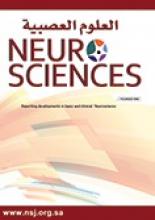Research ArticleOriginal Article
Open Access
Guillain–Barre syndrome: demographics, clinical features, and outcome in a single tertiary care hospital, Oman
Said M. Al Maawali, Almqdad Y. Al Shibani, Ahmed S. Nadeem and Abdullah M. AL-Salti
Neurosciences Journal October 2020, 25 (5) 369-374; DOI: https://doi.org/10.17712/nsj.2020.5.20200057
Said M. Al Maawali
From the department of Neurology, Khoula Hospital, MOH. Muscat-Oman
MD, OMSBAlmqdad Y. Al Shibani
From the department of Neurology, Khoula Hospital, MOH. Muscat-Oman
MD, PhDAhmed S. Nadeem
From the department of Neurology, Khoula Hospital, MOH. Muscat-Oman
MD, PhDAbdullah M. AL-Salti
From the department of Neurology, Khoula Hospital, MOH. Muscat-Oman
MD, FRCPC
References
- ↵
- Katirji B,
- Kaminski HJ,
- Preston DC,
- Ruff RL,
- Shapiro BE
- Gorson KC,
- Ropper AH
- ↵
- Burns TM
- ↵
- Kalita J,
- Misra UK,
- Goyal G,
- Das M
- ↵
- Van Doorn PA,
- Ruts L,
- Jacobs BC
- ↵
- Sejvar JJ,
- Baughman AL,
- Wise M,
- Morgan OW
- ↵
- Ansar V,
- Valadi N
- ↵
- Dash S,
- Pai AR,
- Kamath U,
- Rao P
- ↵
- Fujimura H
- ↵
- Sivadon-Tardy V,
- Orlikowski D,
- Porcher R,
- Sharshar T,
- Durand MC,
- Enouf V,
- et al.
- ↵
- Larsen JP,
- Kvåle G,
- Nyland H
- ↵
- Zaheer M,
- Naeem M,
- Nasrullah M
- ↵
- Sharma G,
- Sood S,
- Sharma S
- ↵
- Hughes RA,
- Swan AV,
- Raphaël JC,
- Annane D,
- van Koningsveld R,
- van Doorn PA
- ↵
- Raphaël JC,
- Chevret S,
- Hughes RA,
- Annane D
- ↵
- Hughes RA,
- Wijdicks EF,
- Benson E,
- Cornblath DR,
- Hahn AF,
- Meythaler JM,
- et al.
- ↵
- Roodbol J,
- de Wit MC,
- Walgaard C,
- de Hoog M,
- Catsman-Berrevoets CE,
- Jacobs BC
- ↵
- McGrogan A,
- Madle GC,
- Seaman HE,
- de Vries CS
- ↵
- Arcila-Londono X,
- Lewis RA
- ↵
- Asbury AK,
- Cornblath DR
- ↵
- Willison HJ,
- Jacobs BC,
- Van Doorn PA
- ↵
- Leonhard SE,
- Mandarakas MR,
- Gondim FAA,
- Bateman K,
- Ferreira MLB,
- Cornblath DR,
- et al.
- Connolly BA,
- Jones GD,
- Curtis AA,
- Murphy PB,
- Douiri A,
- Hopkinson NS,
- et al.
- ↵
- Kleyweg RP,
- van der Meché FG,
- Schmitz PI
- ↵
- Van den Berg B,
- Walgaard C,
- Drenthen J,
- Fokke C,
- Jacobs BC,
- van Doorn PA
- ↵
- Löffel NB,
- Rossi LN,
- Mumenthaler M,
- Lütschg J,
- Ludin HP
- ↵
- Dhadke SV,
- Dhadke VN,
- Bangar SS,
- Korade MB
- ↵
- Bhargava A,
- Banakar BF,
- Pujar GS,
- Khichar S
- ↵
- Anandan C,
- Khuder SA,
- Koffman BM
- ↵
- Karimzadeh P,
- Bakhshande Bali MK,
- Nasehi MM,
- Taheri Otaghsara SM,
- Ghofrani M
- ↵
- Ropper AH
- ↵
- Lawn ND,
- Fletcher DD,
- Henderson RD,
- Wolter TD,
- Wijdicks EF
- ↵
- Van Koningsveld R,
- Rico R,
- Gerstenbluth I,
- Schmitz PI,
- Ang CW,
- Merkies IS,
- et al.
- ↵
- Nachamkin I,
- Barbosa PA,
- Ung H,
- Lobato C,
- Rivera AG,
- Rodriguez P,
- et al.
- ↵
- Gupta D,
- Nair M,
- Baheti NN,
- Sarma PS,
- Kuruvilla A
- ↵
- Sharma A,
- Lal V,
- Modi M,
- Vaishnavi C,
- Prabhakar S
- ↵
- Islam Z,
- Jacobs BC,
- van Belkum A,
- Mohammad QD,
- Islam MB,
- Herbrink P,
- et al.
- ↵
- Haghighi AB,
- Banihashemi MA,
- Zamiri N,
- Sabayan B,
- Heydari ST,
- Safari A,
- et al.
- ↵
- Sriganesh K,
- Netto A,
- Kulkarni GB,
- Taly AB,
- Umamaheswara Rao GS
- ↵
- Winer JB,
- Hughes RAC,
- Greenwood RJ,
- Perkin GD,
- Healy MJR
- Alshekhlee A,
- Hussain Z,
- Sultan B,
- Katirji B
- ↵
- Van den Berg B,
- Bunschoten C,
- van Doorn PA,
- Jacobs BC
- ↵
- Verboon C,
- Doets AY,
- Galassi G,
- Davidson A,
- Waheed W,
- Yann Péréon Y,
- et al.
In this issue
Neurosciences Journal
Vol. 25, Issue 5
1 Oct 2020
Guillain–Barre syndrome: demographics, clinical features, and outcome in a single tertiary care hospital, Oman
Said M. Al Maawali, Almqdad Y. Al Shibani, Ahmed S. Nadeem, Abdullah M. AL-Salti
Neurosciences Journal Oct 2020, 25 (5) 369-374; DOI: 10.17712/nsj.2020.5.20200057
Jump to section
Related Articles
- No related articles found.
Cited By...
- No citing articles found.





